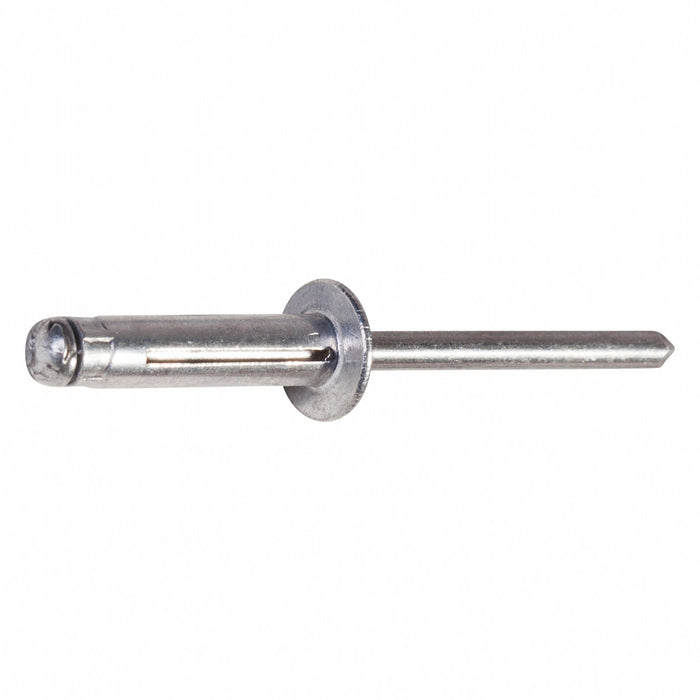Recommended Installation Tools
Tri-Fold Rivet
Brands you know and trust - Aerobolt
Load Spreading Tri Fold Aluminium Rivet.
Trifolds are a split tail rivet designed for applications involving insulated panels, composites, and other low-strength material in caravans, commercial vehicles, mobile homes, recreational vehicles, refrigeration etc. Made of aluminium, the Tri-Fold design allows for a wide variation in material thickness. One rivet can often be used to replace a few rivets: thereby reducing inventory and simplifying stock control.
Tri Fold function well in materials where other rivets fail. The folded legs individually conform to curved surfaces enabling fastening onto pipes, corrugated sheets, and other challenging applications. Oversized or elongated holes can be adequately covered by the large leg formation to resist pull through under stress in high tension-load applications. Seeking a Tri-Fold for a structural application? Go to high strength Tri-Bulb Rivets. Want to learn more about rivets? Check out the rivet blog.
Tri-folding rivet for lightweight applications.
This rivet differs from other types due to its propeller shape blind–side anchor that provides alarge blind side bearing area. These rivets spread their clamping force through the anchor blades whilst providing excellent pull through resistance, making them an ideal choice for panel applications like those associated with pantech & refrigerated trucks. Tri-Fold rivet is renowned for its extended material grip range, enabling a single rivet to cover a greater range of material gauges including curved or uneven surfaces.
Tri-Folding Rivet Advantages.
- Ideal for fiberglass, plastics, composites etc.
- Excellent for curved or uneven surfaces
- One rivet size through thick or thin material.
- Propeller shaped blind side footprint.
Trifolding Rivet Applications.
- Pantech & refrigerated trucks.
- Construction, cladding & more.
Rivet Types

Tri-Fold Rivet - Aluminium Load Spreading Rivets.
Tri-Fold rivets are also known as Bulb-Tite or Tri-Bulb rivets,. A load spreading rivet used in various industries for joining materials together. They are designed for applications where access to only one side of the workpiece is possible. Tri-Fold rivets consist of three parts:
-
Rivet Body: The main body of the rivet, typically made of metal like aluminum or steel. This is the part that goes through the materials being joined.
-
Mandrel: A steel pin that runs through the center of the rivet body. The mandrel has a specific head at one end and a tail at the other.
-
Bulb Section: The section at the tail end of the mandrel, which is shaped like a bulb or three-pronged washer. This bulb section creates a larger bearing surface on the blind side of the workpiece when the rivet is installed.
How to Install Tri Fold Lab.
The installation process of a Tri-Fold rivet involves inserting the rivet body into a pre-drilled hole in the materials to be joined. Once the mandrel is pulled from the opposite side using a specialized rivet gun or tool, it deforms the rivet body, creating a strong, permanent joint.
Tri-fold rivets are commonly used in automotive, aerospace, construction, and various manufacturing industries where the joint needs to be secure without direct access to both sides of the workpiece. They offer advantages like high shear and tensile strength, vibration resistance, and are easy to install with standard riveting equipment.
Tri-folding rivet for lightweight applications.
This rivet differs from other types due to its propeller shape blind–side anchor that provides alarge blind side bearing area. These rivets spread their clamping force through the anchor blades whilst providing excellent pull through resistance, making them an ideal choice for panel applications like those associated with pantech & refrigerated trucks. Tri-Fold rivet is renowned for its extended material grip range, enabling a single rivet to cover a greater range of material gauges including curved or uneven surfaces.
Tri-Folding Rivet Advantages.
- Ideal for fiberglass, plastics, composites etc.
- Excellent for curved or uneven surfaces
- One rivet size through thick or thin material.
- Propeller shaped blind side footprint.
Trifolding Rivet Applications.
- Pantech & refrigerated trucks.
- Construction, cladding & more.
Tri-Fold Rivet - Aluminium Load Spreading Rivets.
Tri-Fold rivets are also known as Bulb-Tite or Tri-Bulb rivets,. A load spreading rivet used in various industries for joining materials together. They are designed for applications where access to only one side of the workpiece is possible. Tri-Fold rivets consist of three parts:
-
Rivet Body: The main body of the rivet, typically made of metal like aluminum or steel. This is the part that goes through the materials being joined.
-
Mandrel: A steel pin that runs through the center of the rivet body. The mandrel has a specific head at one end and a tail at the other.
-
Bulb Section: The section at the tail end of the mandrel, which is shaped like a bulb or three-pronged washer. This bulb section creates a larger bearing surface on the blind side of the workpiece when the rivet is installed.
How to Install Tri Fold Lab.
The installation process of a Tri-Fold rivet involves inserting the rivet body into a pre-drilled hole in the materials to be joined. Once the mandrel is pulled from the opposite side using a specialized rivet gun or tool, it deforms the rivet body, creating a strong, permanent joint.
Tri-fold rivets are commonly used in automotive, aerospace, construction, and various manufacturing industries where the joint needs to be secure without direct access to both sides of the workpiece. They offer advantages like high shear and tensile strength, vibration resistance, and are easy to install with standard riveting equipment.













